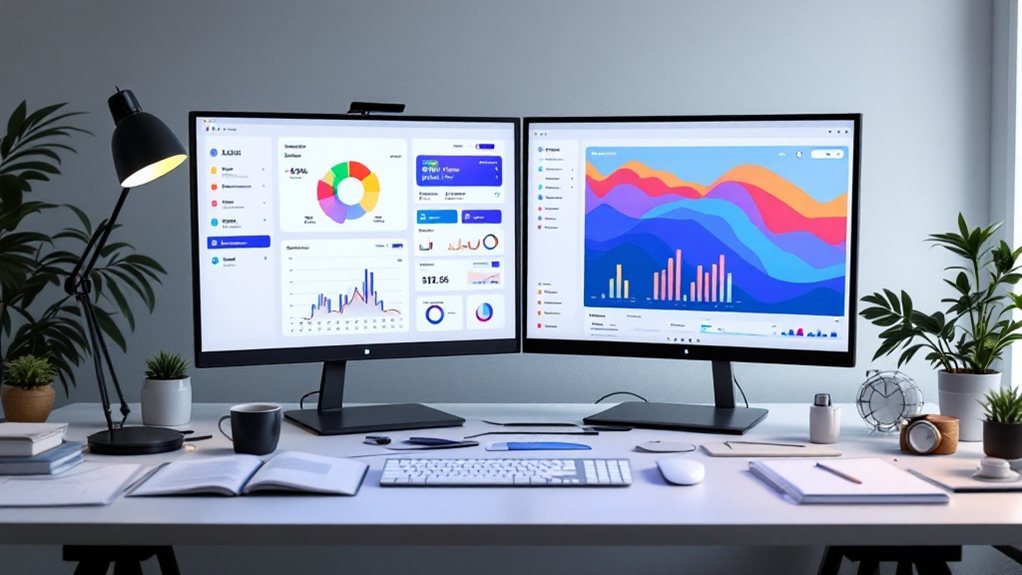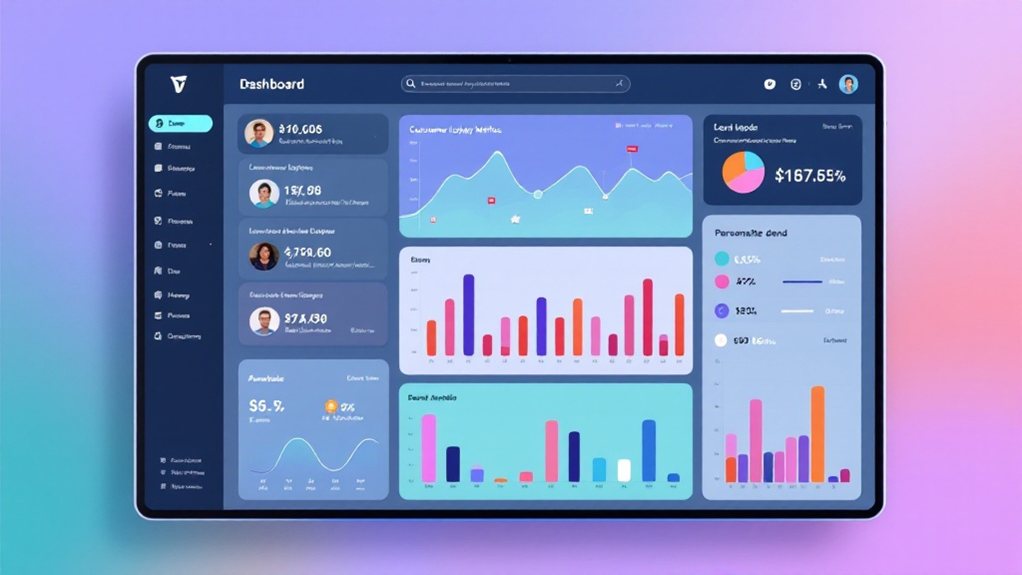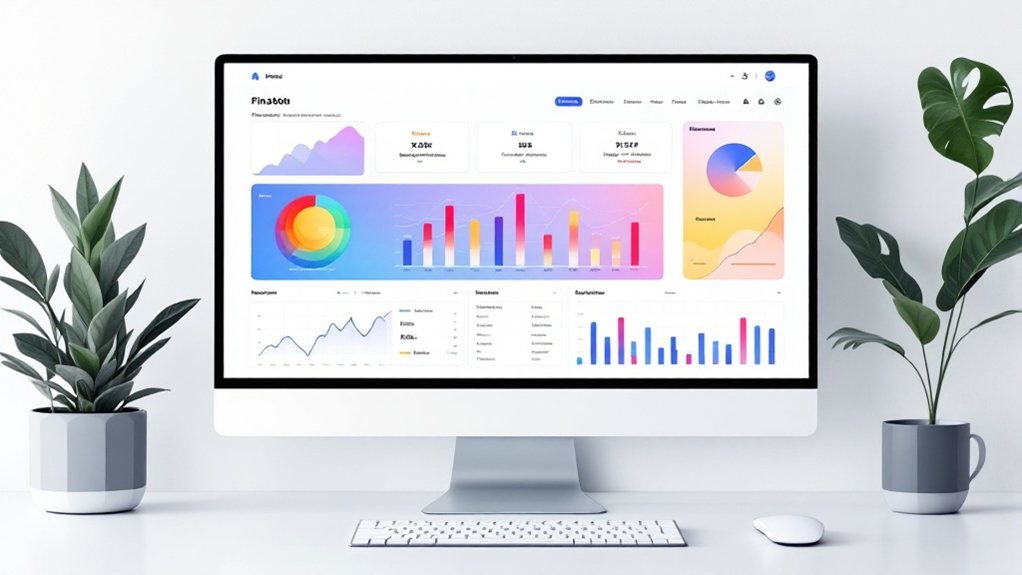Data-driven UX/UI strategies are transforming fintech and banking apps. You can leverage analytics to gain insights into user behavior, optimize digital interfaces through A/B testing, and personalize experiences for distinct customer segments. Predictive analytics enable proactive engagement, while data-driven accessibility enhancements expand your potential customer base. By harnessing the power of data, you can deliver exceptional, user-centric experiences that drive meaningful engagement. To dive deeper into these data-driven approaches…
Key Takeaways
- Leverage data analytics to gain insights into user interactions, track user flows, and identify pain points to optimize UX/UI.
- Implement personalized experiences through customer segmentation, tailoring app features, content, and design to each customer group.
- Utilize A/B testing to identify the most effective design elements and make data-driven decisions about layout, content, and functionality.
- Harness predictive analytics and machine learning to present personalized product recommendations, timely notifications, and contextual support to enhance user experience.
- Prioritize accessibility and inclusivity by identifying pain points and tailoring design to accommodate diverse user needs, expanding the potential customer base.
Understanding User Behavior Through Data Analytics

How do you effectively understand user behavior in fintech and banking applications? By leveraging data analytics, you can gain valuable insights into how users interact with your digital products. From tracking user flows and identifying pain points to analyzing user sentiment and preferences, data-driven approaches provide a holistic understanding of your audience. By monitoring key performance indicators, you can optimize your UX/UI to better meet user needs, reduce friction, and drive engagement. Ultimately, data analytics empowers you to make informed decisions, enhance the user experience, and stay ahead of the competition in the fast-paced fintech and banking landscape.
Leveraging Customer Segmentation for Personalized Experiences
Effective customer segmentation is key to delivering personalized experiences in fintech and banking applications. By analyzing user data, you can identify distinct customer groups with unique needs and behaviors. Leverage this insight to tailor your app's features, content, and design to each segment. Offer personalized recommendations, streamlined workflows, and customized interfaces that resonate with your users. This targeted approach boosts engagement, satisfaction, and loyalty. Plus, it allows you to allocate resources efficiently, addressing the most pressing pain points for each customer group. With data-driven segmentation, you can transform your fintech or banking app into a seamless, personalized experience that keeps users coming back.
Optimizing Digital Interfaces With A/B Testing

Once you've gathered insightful data on your users, A/B testing digital interfaces can help you refine their experience. By creating two or more variations of a user interface and analyzing how users interact with each, you can identify the most effective design elements. This allows you to make data-driven decisions about layout, content, and functionality. A/B testing can uncover surprising insights, like which call-to-action button performs better or how small changes to the user flow impact conversion rates. By continuously optimizing your digital interfaces, you'll deliver experiences that better meet your customers' needs and drive greater engagement with your fintech or banking app.
Harnessing Predictive Analytics for Proactive Engagement
Predictive analytics can empower you to anticipate your customers' needs and proactively engage them. By leveraging historical data and machine learning algorithms, you can forecast user behavior and tailor your digital interfaces accordingly. This enables you to present personalized product recommendations, timely notifications, and contextual support, enhancing the user experience and driving deeper customer engagement. Moreover, predictive analytics can help you identify high-value segments, optimize marketing campaigns, and enhance risk management – all crucial for fintech and banking applications. Embrace the power of data-driven insights to stay ahead of the curve and deliver exceptional, proactive experiences that delight your customers.
Enhancing Accessibility and Inclusivity With Data-Driven Insights

As you leverage data-driven insights, you can also enhance the accessibility and inclusivity of your fintech and banking applications. By analyzing user behavior and feedback, you can identify pain points and tailor your design to accommodate diverse user needs. This may involve implementing features like screen readers, color contrast adjustments, and intuitive navigation. Additionally, you can use data to inform personalized experiences, ensuring your app is accessible and engaging for users of all abilities. By prioritizing accessibility and inclusivity, you'll not only improve the user experience but also expand your potential customer base and demonstrate your commitment to inclusive design practices.
Streamlining User Onboarding Through Data-Driven Techniques
Streamlining the user onboarding process is paramount in fintech and banking applications. By leveraging data-driven insights, you can create a seamless and efficient onboarding experience. Analyze user behavior data to identify pain points and optimize the flow. Implement smart form fields that autofill and reduce friction. Utilize dynamic content to personalize the experience based on user preferences and goals. Provide clear instructions and contextual guidance to mitigate confusion. Continuously test and iterate based on user feedback to ensure the onboarding process is intuitive and effective. Data-driven onboarding enhances user satisfaction, boosts conversions, and sets the stage for long-term engagement.
Improving Customer Retention With Data-Driven Loyalty Programs

Retaining valuable customers is crucial for the long-term success of fintech and banking applications. By leveraging data-driven loyalty programs, you can effectively keep your customers engaged and loyal. Analyze their behaviors, preferences, and pain points to create personalized rewards and incentives that resonate with them. Offer tiered membership levels, exclusive benefits, and seamless redemption options to foster a sense of belonging and appreciation. Integrate these programs into your user experience, making it effortless for customers to earn and redeem rewards. Continuously optimize your loyalty initiatives based on data insights, ensuring they evolve with your customers' needs. Effective data-driven loyalty programs can significantly improve customer retention, solidifying your fintech or banking app's position in the competitive landscape.
Driving Financial Wellness Through Data-Powered Recommendations
By empowering your fintech or banking app users with data-powered recommendations, you can unlock their path to financial wellness. Leverage user data to provide personalized guidance on budgeting, savings, and smart spending. Intelligent algorithms analyze their transaction history, goals, and behavioral patterns to suggest tailored strategies. This enhances their financial decision-making, fostering improved money management skills and long-term financial security. Moreover, nudging users towards healthier financial habits increases app engagement and loyalty. Data-driven recommendations empower your customers, positioning your fintech or banking app as a trusted partner in their journey towards financial well-being.
Integrating Data-Driven UX/UI Across the Fintech Ecosystem

As you look to enhance the user experience across your fintech ecosystem, integrating data-driven UX/UI becomes paramount. By harnessing insights from customer data, you can tailor interactions and interfaces to individual needs. This personalized approach fosters deeper engagement and loyalty. Leverage analytics to identify pain points, optimize workflows, and deliver seamless digital experiences. Empower your team to make data-informed design decisions, empowering them to create intuitive, user-centric solutions. Ensure data security and privacy remain top priorities as you integrate these insights. Ultimately, a cohesive, data-driven UX/UI strategy enables you to differentiate your fintech offerings and drive sustained growth within the evolving ecosystem.

